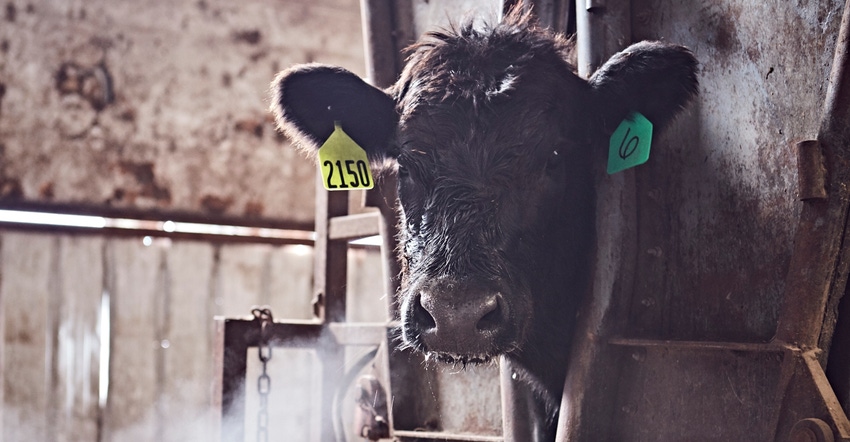Welcome to Health Ranch, where you can find information and resources to help you put the health and well-being of your cattle at the top of the priority list.
Diagnosing BRD early: Win the game of hide-and-seek
Cattle behavior makes an early diagnosis of bovine respiratory disease (BRD) in calves a game of hide-and-seek.
November 1, 2022

Sponsored Content
The natural behavior of cattle makes early diagnosis of bovine respiratory disease a game of hide-and-seek. Calves are a prey species, so they’re instinctively good at hiding behind their healthy pen mates and masking illnesses from us.
“Calves don’t want to appear to be weak, so even when they’re not feeling well, they will pick their heads up and move normally within the group,” said Jody Wade, DVM, Boehringer Ingelheim. “They’ll go to the bunk and put their head down, just like the rest of the calves, but may not eat a bite.”
Finding sick calves early is critical. If producers are not paying close attention, they can lose calves without recognizing the severity of the disease. Even those animals that survive can suffer from lifelong lung damage that curtails future health and productivity.
Tips for observing the telltale signs of BRD
The first signs of BRD in calves are loss of appetite and slow, lethargic behavior. These symptoms may be quickly followed by labored breathing, discharge from the eyes or nose, coughing, depression, and a drooped head and ears.
“The key to keeping calves healthy and doing well is to recognize signs of illness and treat them as early as possible, almost when the animal is on the verge of getting sick,” said Dr. Wade. “That means observing them regularly and consistently, yet being as inconspicuous as possible.”
Dr. Wade compared an experience he had with a colleague, walking through feedlot pens to find calves with respiratory illness, then observing the same pen of calves from a distance using binoculars.
“When we didn’t walk into the pen and stir the cattle up, it was amazing how many calves showed signs of respiratory illness because they didn’t realize they were being watched,” Dr. Wade noted. Once calves that may be sick are identified, rectal temperature checks for fever and listening to the animal’s breathing for sounds of abnormal lung function can verify the onset of respiratory disease.
Early diagnosis for early treatment
Bacterial pathogens such as Mannheimia haemolytica, Pasteurella multocida, Mycoplasma bovis and Histophilus somni are four of the most predominant upper-respiratory pathogens impacting cattle. These pathogens cause inflammation in the lungs very quickly. Left unchecked, this inflammation can cause permanent damage in the lungs.
“If we can find calves at the beginning of the illness, at the beginning of that inflammatory stage, and support them with a broad-spectrum antibiotic that is going to work quickly, perhaps in as little as 30 minutes, we’re going to have a much better chance of the calf returning to health with little or no lung damage,” Dr. Wade said.
Support with an antibiotic
A common misconception is that antibiotics cure diseases in animals. Dr. Wade points out that antibiotics are, in fact, designed to reduce the ability of bacterial pathogens to reproduce in the animal’s body.
“What we’re doing with an antibiotic treatment is allowing the animal’s immune system to function properly and eliminate the pathogens from its body,” he explained. ��“We’ve learned that by minimizing stress after treatment and returning the calf to its original group, the calf is more likely to be comfortable, have less stress, and go back on feed and water, which are all important for its recovery.”
In addition to administering an antibiotic that works quickly, Dr. Wade recommends choosing an antibiotic such as a long-acting macrolide that works over an extended period. This type of product gets the calf on the road to recovery and reduces stress from frequent handling and repeated separation from its group.
To win the game of BRD hide-and-seek, it’s key to find and treat calves as close to the onset of illness as possible. “If you see a calf that looks like he may be sick, don’t wait. Get him in and treat him,” Dr. Wade said. “And don’t just guess. Involve your local veterinarian to help with diagnostics so you know what pathogens you’re dealing with.”
For herds experiencing BRD, your local veterinarian can help identify the pathogen involved, select a suitable antibiotic, and establish a sound treatment protocol. Your veterinarian is familiar with your herd as well as the pathogens common in your area, and is an important resource to help pinpoint the cause of disease through diagnostics and help get your calves on the path to recovery.
©2022 Boehringer Ingelheim Animal Health USA Inc., Duluth, GA. All Rights Reserved. US-BOV-0474-2022-A
About the Author(s)
You May Also Like
